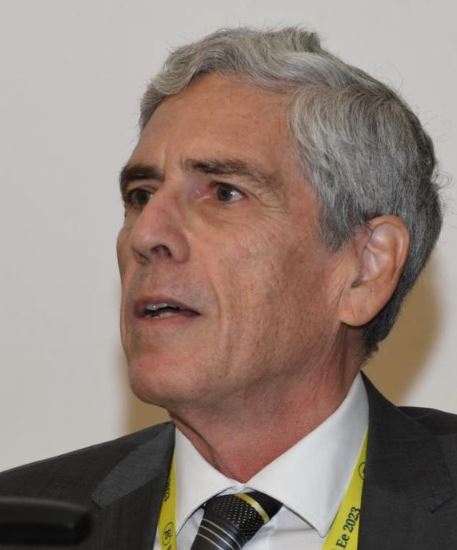Vladimir KATIĆ
Professor, Faculty of Technical Sciences, University of Novi Sad, Novi Sad, Serbia
Research interests:
Power Quality, Renewable Energy Sources, Power Electronics, Electric Vehicles and Transportation and Standardization in Electrical Engineering.
Keynote address:
Modern Methods of Power Quality Analysis
Abstract:
Modern power systems are moving toward smart grids bringing new multilayer structures and digitalization. They enable and demand the application of advanced communication systems, vast networks of sensors and measurement spots, high-capacity computer networks with big-data handling possibilities, the multi-level-digital control structure of the power system, high-efficiency power-electronics-based microprocessor-controlled loads, and different renewable energy generation sources characterized with low-inertia and intermittency. Furthermore, distributed generation and smart grid structure enable splitting the system into microgrids with autonomous or semi-autonomous operation, and the possibility of using DC systems, energy storage, and bilateral EV loads. Traditional sinusoidal voltage and current waveforms generated by synchronous generators over the years become more and more distorted, requiring increasing attention on power quality (PQ) issues. There are different types of PQ disturbances, but voltage distortions and disturbances, like harmonics, sags/swells, flicker, interruptions, etc., are the most interesting ones. Each type of PQ disturbance is characterized by a specific signal signature (feature), which can be adequately detected, classified, characterized, and recognized as a possible threat (or not) to normal operation. Modern methods of the PQ signals treatment are based on traditional Nyquist methods and different analysis approaches are available. However, digital signatures of the PQ disturbances may be analyzed with advanced digital signal processing methods, like parametric, nonparametric, and hybrid ones. Recently, compressive sensing methods have been introduced for signal digital treatment and transmission, while for the disturbances classification, characterization, and possible localization artificial intelligence, through machine learning was applied. The lecture is intended to give an overview of different PQ signals, their characteristic features (in synthetic or real form), and different methods in their detection, classification, and characterization. The methods using harmonic footprint as a feature and some of the deep-learning algorithms for voltage sags analysis will be presented in more detail.
Vladimir KATIĆ from the University of Novi Sad, the Faculty of Technical Sciences in Novi Sad, Serbia, received his B.Sc. degree from the University of Novi Sad in 1978 and M.Sc. and Ph.D. degrees from the University of Belgrade in 1981 and 1991, respectively, all in Electrical Engineering.
He is the author or co-author of 22 scientific monographs, textbooks, and teaching materials (scripts). The most important are: "Power Electronics 1 – Components and AC/x converters" (2020), "Power Electronics 2 – DC/x converters and power supplies" (2020), "Power Quality – problems and laboratory exercises" (2018), "Renewable electrical energy sources – problems" (2018), "Real-Time Modeling of Power Electronics Converters" (2011), "Electric Power Quality" (2007), "Renewable Sources of Electrical Energy" (2007), "Microprocessor Applications in Power Engineering" (2006), and a Monograph "Electric Power Quality - Harmonics" (2002), all in Serbian.
Prof. Katic is the author or co-author of more than 600 scientific papers published in international and national journals or conference proceedings. His papers have been cited over 1250 times with h=15 (according to the Scopus), and over 2500 times, with h=22 (according to Google Scholar). He is an active reviewer with over 700 reviews recorded at the Clarivate Web of Science. Prof. Katic has been the head, main researcher, and researcher in 14 international and around 50 national scientific projects or studies.
He is an Academic Editor and member of the Editorial Board of 21 scientific journals, and a Member of Program or Steering Committees of more than 75 International Conferences around the World. He chaired numerous international and national conferences, among which the International Conference EPE-PEMC 2012 ECCE Europe, EUROCON 2019, and the biannual International Symposium on Power Electronics (Ee) are the most known. Prof. Katić is a Life Senior Member of the IEEE (USA). He is also the Founder and the President of the Power Electronics Society of Serbia (Novi Sad, Serbia), a Member of the Executive Council of the European Power Electronics Association (EPE, Brussels, Belgium), a Member of the Executive Council of the Power Electronics and Motion Control (PEMC, Budapest, Hungary), a President of the Society of ETRAN (Belgrade, Serbia), and a Founder and a Member of the Executive Board of the National Committee of CIRED (Novi Sad, Serbia).
He is an Academic Editor and member of the Editorial Board of 21 scientific journals, and a Member of Program or Steering Committees of more than 75 International Conferences around the World. He chaired numerous international and national conferences, among which the International Conference EPE-PEMC 2012 ECCE Europe, EUROCON 2019, and the biannual International Symposium on Power Electronics (Ee) are the most known. Prof. Katić is a Life Senior Member of the IEEE (USA). He is also the Founder and the President of the Power Electronics Society of Serbia (Novi Sad, Serbia), a Member of the Executive Council of the European Power Electronics Association (EPE, Brussels, Belgium), a Member of the Executive Council of the Power Electronics and Motion Control (PEMC, Budapest, Hungary), a President of the Society of ETRAN (Belgrade, Serbia), and a Founder and a Member of the Executive Board of the National Committee of CIRED (Novi Sad, Serbia).


